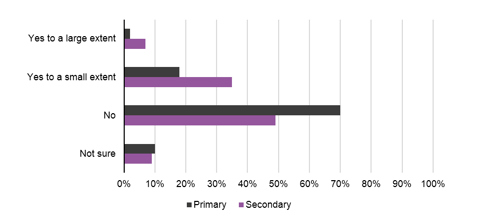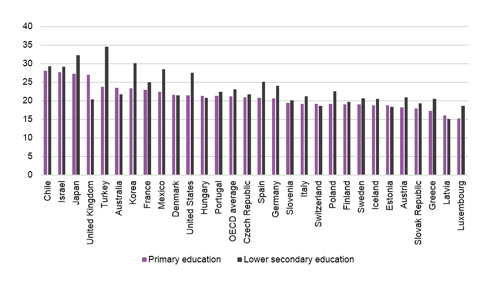Would teachers be willing to take on larger classes for more non-contact time?
Tuesday 20 November 2018
Andreas Schleicher, the Director of Education and Skills at the OECD, has recently argued that giving teachers more time for non-teaching activities, such as continuing professional development (CPD) and lesson planning, is a prominent feature of high performing countries. They achieve this by taking on larger class sizes in return for more non-contact time. In this blog post, we aim to contribute to the debate by exploring what teachers in England think about this trade-off.
At the 2018 Sutton Trust ‘Best in Class’ social mobility summit, Andreas Schleicher gave a presentation on raising excellence and equity in education. He explained that it is the “quality of the instruction environment”, not the amount of teaching time, which is important for pupils’ learning and the rate that they progress. Mr Schleicher said that teacher quality appeared to be better in higher performing countries, and a feature of these systems was that teachers have more non-contact time to do activities like professional development, lesson preparation and marking, etc. This additional non-contact time appears to be achieved by teachers having larger class sizes. Mr Schleicher proposed that this approach might be worthy of consideration in other countries.
Why should this trade-off between teaching time and non-contact time matter? Well, we know that teacher quality is important to pupils’ learning and that it particularly benefits disadvantaged pupils, where the difference between having a highly effective teacher and a poorly performing teacher is a whole year’s learning. Therefore, investing in teacher quality by increasing non-contact time in return for larger class sizes could have a positive impact on social mobility.
What do teachers in England think about this idea?
So would teachers in England be willing to contemplate teaching larger classes in return for more non-contact time? We were unsure about what to expect but we anticipated that most teachers would not support the idea as, for example, IoE research shows teachers in England do not feel the need for more CPD. In order to find out, we posed the following question to a nationally representative sample of primary and secondary teachers through our Teacher Voice survey:
“Teachers in some countries have more non-contact time for planning and CPD but they also teach larger classes. Would you be prepared to teach a larger class in return for greater non-contact time?”
The survey results show that although a majority of teachers were not in favour of the proposal, about a third of those asked – 32 per cent - were willing to contemplate it to a small (or larger) extent.
As shown in Figure 1, there were also some clear differences between primary and secondary teachers, with just over 40 per cent of secondary teachers willing to support the idea compared to 20 per cent of primary teachers.
Figure 1: Secondary teachers were more willing to consider the proposed trade-off

One of the reasons for the difference between the two phases might be that UK primary teachers in public institutions already teach relatively large classes (of 27 pupils on average) compared to primary teachers in other countries (Figure 2). On the other hand, secondary class sizes in the UK are relatively small (at 20 pupils on average) in comparison to other OECD countries.
Figure 2: Average UK primary class sizes are above the OECD average

What were the reasons they gave for their responses?
Our survey also asked teachers to explain the reasons for their answers. Teachers gave a number of reasons both for and against the idea.
The most common reasons that teachers gave for being against the proposal were that they thought classes were already large enough and that larger classes would have a negative impact on their workload by increasing the amount of planning and marking. They were also worried that it would reduce the amount of attention they could give to individual pupils during lessons and that this could have a negative impact on their learning. In contrast, teachers who were willing to consider the idea thought that it would help them to reduce their workload by freeing up time to plan lessons and mark work effectively.
Not surprisingly, a number of teachers had questions about implementation and how it would work in practice. For example, how much larger would class sizes have to be? There were also questions about the type and quality of CPD that teachers would be able to access? Clearly the quality of CPD is important. Teachers have little to gain by spending time on ineffective CPD and a recent study has indicated that teachers in England spend less time on ‘effective’ CPD than their counterparts in other countries.
The aim of the Teacher Voice survey question was to ‘test the water’ to see whether teachers in England would be open to the idea of exploiting a trade-off between class size and non-contact time. It seems from our initial exploration that a significant minority (40%) of secondary teachers would be prepared to consider it. Clearly, more work would be required to develop this proposition further, to explore the types of issues such as the impact of larger class sizes on teachers and pupils, which our respondents raised in our survey. However, we hope that this small piece of research has helped to further this debate a little and add support for the proposition to be explored further.
More information about our Teacher Voice survey can be found here.
